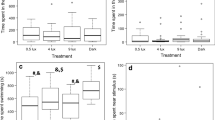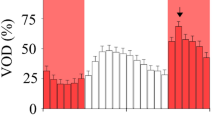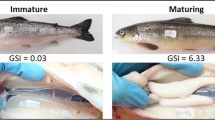Abstract
Flora and fauna have both evolved under a natural cycle of light and dark. But especially in urban areas, the night is now increasingly disturbed by artificial light. Many traits and behaviours in fish are triggered by a circadian clock, for example hatching and swim bladder inflation, which predominantly take place at dusk or night. As lighting becomes brighter and extends farther into rural areas, the distinction between day and night becomes increasingly blurred. Therefore, the loss of diurnal trigger by artificial light at night was hypothesized having deleterious effects on these traits and impact fish reproduction. To assess these effects, eggs of four native freshwater fishes, Eurasian perch Perca fluviatilis, roach Rutilus rutilus, bleak Alburnus alburnus and chub Leuciscus cephalus, were incubated under two different light conditions: a photoperiod of 14 h light:10 h darkness (LD) and continuous illumination (LL). The time to hatch and swim bladder inflation was recorded. The species showed inconsistent reactions to the light treatments. In roach and bleak, the time to 50% hatch was longer in LL, whereas continuous lighting had an accelerating effect in chub. Incubation in LL elongated the hatching period in perch and roach and, in perch, the onset of darkness seemed to trigger hatching. The swim bladder inflation was significantly promoted by continuous light in chub and bleak but was not affected in roach. In conclusion, nocturnal artificial illumination could have an effect on hatching and initial swim bladder filling by masking the day–night-change and thereby diminish the trigger effect. However, the reactions were species specific and the increase in variation indicated a lack of diurnal triggering, whilst a general deleterious effect of artificial light at night has not been identified on early life stages.





Similar content being viewed by others
References
Andersen J (2001) History, strategy and status of IAU actions. In: Cohen RJ, Sullivan WT (eds) Preserving the astronomical sky. IAU Symposium 196, Vienna, Austria, 12–16 July 1999, vol 10, pp 16–21
Baird OE, Krueger CC (2000) Behaviour of lake trout sac fry: vertical movement at different developmental stages. J Great Lakes Res 26:141–151
Barahona-Fernandes MH (1979) Some effects of light intensity and photoperiod on the sea bass larvae (Dicentrarchus labrax (L.)) reared at the Center Oceanologique de Bretagne. Aquaculture 17:311–321
Battaglene SC, Talbot RB (1990) Initial swim bladder inflation in intensively-reared Australian bass larvae, Macquaria novemaculeata (Steindachner) (Perciformes: Percichthyidae). Aquaculture 86:431–442
Battaglene SC, Talbot RB (1992) Induced spawning and larval rearing of snapper, Pagrus auratus (Pisces: Sparidae), from Australian waters. N Z J Mar Fresh 26:179–183
Battaglene SC, McBride S, Talbot RB (1994) Swimbladder inflation in larvae of cultured sand whiting, Sillago ciliata Cuvier (Sillaginidae). Aquaculture 128:177–192
Batty RS (1987) Effect of light intensity on activity and food-searching of larval herring, Clupea harengus: a laboratory study. Mar Biol 94:323–327
Bourgeois S, Gilot-Fromont E, Viallefont A, Boussamba F, Deem SL (2009) Influence of artificial lights, logs and erosion on leatherback sea turtle hatchling orientation at Pongara National Park, Gabon. Biol Conserv 142:85–93
Bramm ME, Lassen MK, Liboriussen L, Richardson K, Ventura M, Jeppesen E (2009) The role of light for fish-zooplankton–phytoplankton interactions during winter in shallow lakes—a climate change perspective. Freshw Biol 54:1093–1109
Brännas E (1987) Influence of photoperiod and temperature on hatching and emergence of Baltic salmon (Salmo salar L.). Can J Zool 65:1503–1508
Brooke LT (1975) Effect of different constant incubation temperatures on egg survival and embryonic development in lake whitefish (Coregonus clupeaformis). Trans Am Fish Soc 104:555–559
Bunn NA, Fox CJ, Webb T (2000) A literature review of studies on fish egg mortality: implications for the estimation of spawning stock biomass by the annual egg production method. CEFAS, Sci Ser Tech Rep 111:1–37
Cahill GM (1996) Circadian regulation of melatonin production in cultured zebrafish pineal and retina. Brain Res 708:177–181
Calta M (2000) Morphological development and growth of chub. Leuciscus cephalus (L.) larvae. J Appl Ichthyol 16:83–85
Cerny K (1975) Mortality of the early developmental stages of the roach—Rutilus rutilus (Linnaeus 1758). Vest Cesk Spol Zool 39:81–93
Chatain B (1990) Problems related to the lack of functional swimbladder in intensive rearing of Dicentrarchus labrax and Sparus auratus. Adv Trop Aquacult AQUACOP IFREMER Actes de Colloque 9:699–709
Copp GH, Faulkner H, Doherty S, Watkins MS, Majecki J (2002) Diel drift behaviour of fish eggs and larvae, in particular barbel. Barbus barbus (L.) in an English chalk stream. Fish Manag Ecol 9:95–103
Crawford DL (2000) Light pollution, an environmental problem for astronomy and for mankind. Mem Soc Astron Ital 71:11–40
Czesny SJ, Graeb BDS, Dettmers JM (2005) Ecological consequences of swim bladder noninflation for larval yellow perch. Trans Am Fish Soc 134:1011–1020
De Vlaming VL, Sage M, Charlton CB, Tiegs B (1974) The effects of melatonin on lipid deposition in cyprinodontid fishes and on pituitary prolactin activity in Fundulus similis. J Comp Physiol 94:309–319
Downing G, Litvak MK (2002) Effects of light intensity, spectral composition and photoperiod on development and hatching of haddock (Melanogrammus aeglefinus) embryos. Aquaculture 213:265–278
Duncan NJ, Ibarra-Castro L, Alvarez-Villasenor R (2008) Effect of the dusk photoperiod change from light to dark on the incubation period of eggs of the spotted rose snapper, Lutjanus guttatus (Steindachner). Aquac Res 39:427–433
Eisenbeis G (2006) Artificial night lighting and insects: Attraction of insects to streetlamps in a rural setting in Germany. In: Rich C, Longcore T (eds) Ecological consequences of artificial night lighting. Island Press, Washington, DC, pp 281–304
Ekström P, Meissl H (1997) The pineal organ of teleost fishes. Rev Fish Biol Fish 7:199–284
Ekström P, Borg B, Van Veen T (1983) Ontogenetic development of the pineal organ, parapineal organ, and retina of the three-spined stickleback, Gasterosteus aculeatus L. (Teleostei). Cell Tissue Res 233:593–609
Falcón J, Guerlotté J, Voisin P, Collin JP (1987) Rhythmic melatonin biosynthesis in a photoreceptive pineal organ: a study in the pike. Neuroendocrinology 45:479–486
Falcón J, Marmillon JB, Claustrat B, Collin JP (1989) Regulation of melatonin secretion in a photoreceptive pineal organ: an in vitro study in the pike. J Neurosci 9:1943–1950
Forward RB, McKelvey LM, Hettler WF, Hoss DE (1993) Swimbladder inflation of the Atlantic menhaden Brevoortia tyrannus. Fish Bull 91:254–259
Forward RB, Hettler WF, Hoss DE (1994) Swimbladder deflation in the Atlantic menhaden Brevoortia tyrannus. Fish Bull 92:641–646
Gozlan RG, Copp GH, Tourenq JN (1998) Early development of the sofie, Chondrostoma toxosomata. Environ Biol Fishes 56:67–77
Gray J (1928) The growth of fish: III. The effect of temperature on the development of the eggs of Salmo Fario. J Exp Biol 6:125–130
Haas R, Kräling W, Boulois R (1997) Lichtkontamination. Umweltwiss Schadstoff-Forsch 9:24
Hansen TK, Falk-Petersen IB (2001) The influence of rearing temperature on early development and growth of spotted wolfish Anarhichas minor (Olafsen). Aquac Res 32:369–378
Helvik JV, Walther BT (1992) Photo-regulation of the hatching process of halibut (Hippoglossus hippoglossus) eggs. J Exp Zool 263:204–209
Helvik JV, Walther BT (1993) Environmental parameters affecting induction of hatching in halibut (Hippoglossus hippoglossus) embryos. Mar Biol 116:39–45
Hölker F, Moss T, Griefahn B, Kloas W, Voigt CC, Henckel D, Hänel A, Kappeler PM, Völker S, Schwope A, Franke St, Uhrlandt D, Fischer J, Wolter C, Tockner K (2010a) The dark side of light—a transdisciplinary research agenda for light pollution policy. Ecol Soc 15
Hölker F, Wolter C, Perkin EK, Tockner K (2010b). Light pollution as a biodiversity threat. Trends Ecol Evol. doi:10.1016/j.tree.2010.09.007
Hoss DE, Phonlor G (1984) Field and laboratory observations on diurnal swim bladder inflation–deflation in larvae of gulf menhaden, Brevoortia patronus. Fish Bull 82:513–517
Houde ED (1975) Effects of stocking density and food density on survival. growth and yield of laboratory-reared larvae of sea bream Archosargus rhomboidales (L.) (Sparidae). J Fish Biol 7:115–127
Hunter JR, Koyne KM (1982) The onset of schooling in northern anchovy larvae, Engraulis mordax. Calcofi Rep 23:246–251
Hunter JR, Sanchez C (1976) Diel changes in swim bladder inflation of the larvae of the northern anchovy, Engraulis mordax. Fish Bull 74:847–855
Iigo M, Furukawa K, Hattori A, Ohtani-Kaneko R, Hara M, Suzuki T, Tabata M, Aida K (1997) Ocular melatonin rhythms in the goldfish, Carassius auratus. J Biol Rhythm 12:182–192
Imsland AK, Folkvord A, Stefansson SO (1995) Growth, oxygen consumption and activity of juvenile turbot (Scophthalmus maximus L.) reared under different temperatures and photoperiods. Neth J Sea Res 34:149–159
Karjalainen J (1992) Food ingestion, density-dependent feeding and growth of vendace (Coregonus albula (L.)) larvae. Ann Zool Fennici 26:93–103
Karnad D, Isvaran K, Kar CS, Shanker K (2009) Lighting the way: towards reducing misorientation of olive ridley hatchlings due to artificial lighting at Rushikulya, India. Biol Conserv 142:2083–2088
Kestemont P, Jourdan S, Houbart M, Mélard C, Paspatis M, Fontaine P, Cuvier A, Kentouri M, Baras E (2003) Size heterogeneity, cannibalism and competition in cultured predatory fish larvae: biotic and abiotic influences. Aquaculture 227:333–356
Kezuka H, Furukawa K, Aida K, Hanyu I (1988) Daily cycles in plasma melatonin levels under long or short photoperiod in the common carp, Cyprinus carpio. Gen Comp Endocr 72:296–302
Kindschi GA, Barrows FT (1993) Survey of swim bladder inflation in walleyes reared in hatchery production ponds. Prog Fish Cult 55:219–223
Longcore T, Rich C (2004) Ecological light pollution. Front Ecol Environ 2:191–198
Lowe RH (1952) The influence of light and other factors on the seaward migration of the silver eel (Anguilla anguilla L.). J Anim Ecol 21:275–309
Martin-Robichaud DJ, Peterson RH (1998) Effects of light intensity, tank colour and photoperiod on swimbladder inflation success in larval striped bass, Morone saxatilis (Walbaum). Aquac Res 29:539–547
Marty GD, Hinton DE, Cech JJ (1995a) Oxygen consumption by larval Japanese medaka with inflated or uninflated swim bladders. Trans Am Fish Soc 124:623–627
Marty GD, Hinton DE, Summerfelt RC (1995b) Histopathology of swimbladder noninflation in walleye (Stizostedion vitreum) larvae: role of development and inflammation. Aquaculture 138:35–48
McAlary FA, McFarland WN (1993) The Effect of light and darkness on hatching in the pomacentrid Abudefduf saxatilis. Environ Biol Fishes 37:37–244
Meehan WE (1913) Modern fish culture in fresh and salt water. Forest and Stream. Pub. Co., New York
Miller TJ, Crowder LB, Rice JA, Marschall EA (1988) Larval size and recruitment mechanisms in fishes: toward a conceptual framework. Can J Fish Aquat Sci 45:1657–1670
Oesmann S (2003) Vertical, lateral and diurnal drift patterns of fish larvae in a large lowland river, the Elbe. J Appl Ichthyol 19:284–293
Östholm T, Brännäs E, Van Veen T (1987) The pineal organ is the first differentiated light receptor in the embryonic salmon, Salmo salar L. Cell Tissue Res 249:641–646
Partridge BL (1982) The structure and function of fish schools. Sci Am 245:114–123
Pitcher TJ, Parrish JK (1993) Function of shoaling behaviour in teleosts. In: Pitcher TJ (ed) Behaviour of teleost fish. Chapman & Hall, London, pp 363–439
Porter MJR, Duncan N, Mitchell D, Bromage NR (1999) The use of cage lighting to reduce plasma melatonin in Atlantic salmon (Salmo salar) and its effects on the inhibition of grilsing. Aquaculture 176:237–244
Puvanendran V, Brown JA (2002) Foraging, growth and survival of Atlantic cod larvae reared in different light intensities and photoperiods. Aquaculture 214:131–151
Reichard M, Jurajda P, Ondračková M (2002) The effect of light intensity on the drift of young-of-the-year cyprinid fishes. J Fish Biol 61:1063–1066
Reichard M, Jurajda P, Smith C (2004) Spatial distribution of drifting cyprinid fishes in a shallow lowland river. Arch Hydrobiol 159:395–407
Riegel KW (1973) Light pollution. Science 179:1285–1291
Schoots AFM, de Bont RG, van Eys GJJM, Denucé JM (1982) Evidence for a stimulating effect of prolactin on teleostean hatching enzyme secretion. J Exp Zool 219:129–132
Shepherd JG, Cushing DH (1980) A mechanism for density-dependent survival of larval fish as the basis of a stock–recruitment relationship. J Cons Int Explor Mer 39:160–167
Takashi T, Kohno H, Sakamoto W, Miyashita S, Murata O, Sawada Y (2006) Diel and ontogenetic body density change in Pacific bluefin tuna, Thunnus orientalis (Temminck and Schlegel), larvae. Aquac Res 37:1172–1179
Tamai TK, Vardhanabhuti V, Foulkes NS, Whitmore D (2004) Early embryonic light detection improves survival. Curr Biol 14:104–105
Trotter AJ, Battaglene SC, Pankhurst PM (2003) Effects of photoperiod and light intensity on initial swim bladder inflation, growth and post-inflation viability in cultured striped trumpeter (Latris lineata) larvae. Aquaculture 224:141–158
Trotter AJ, Battaglene SC, Pankhurst PM (2005) Buoyancy control and diel changes in swim-bladder volume in cultured striped trumpeter (Latris lineata) larvae. Mar Freshw Res 56:361–370
Underwood H (1989) The pineal and melatonin: regulators of circadian function in lower vertebrates. Experientia 45:914–922
Villareal CA, Thorpe JE, Miles MS (1988) Influence of photoperiod on growth changes in juvenile Atlantic salmon, Salmo salar L. J Fish Biol 33:15–30
Vøllestad LA, Jonsson B, Hvidsten NA, Næsje TF, Haraldstad Ø, Ruud-Hansen J (1986) Environmental factors regulating the seaward migration of European silver eels (Anguilla anguilla). Can J Fish Aquat Sci 43:1909–1916
Welker MT, Pierce CL, Wahl DH (1994) Growth and survival of larval fishes: roles of competition and zooplankton abundance. Trans Am Fish Soc 123:703–717
Woodhead PMJ (1957) Reactions of salmonid larvae to light. J Exp Biol 34:402–416
Zitek A, Schmutz S, Ploner A (2004) Fish drift in a Danube sidearm-system: II. Seasonal and diurnal patterns. J Fish Biol 65:1339–1357
Author information
Authors and Affiliations
Corresponding author
Rights and permissions
About this article
Cite this article
Brüning, A., Hölker, F. & Wolter, C. Artificial light at night: implications for early life stages development in four temperate freshwater fish species. Aquat Sci 73, 143–152 (2011). https://doi.org/10.1007/s00027-010-0167-2
Received:
Accepted:
Published:
Issue Date:
DOI: https://doi.org/10.1007/s00027-010-0167-2




